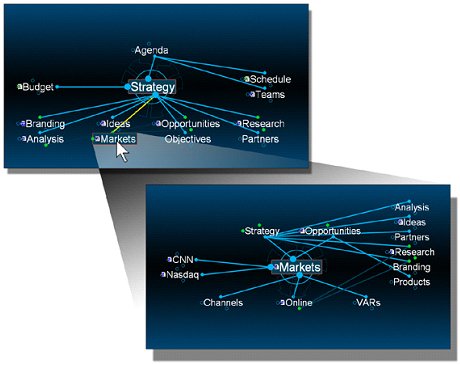TheBrain
We're introducing TheBrain application here because it shares a lot conceptually with the interface we're in the process of defining, if you're unfamiliar with TheBrain, see this blog post for a quick introduction to the concept first.
To the right is an image of TheBrain which is essentially a graphical concept and relationship mapping tool. It's very similar to a mind-mapping tool, except that it's more node-oriented which allows more intuitive navigation around large complex structures of nodes and for diverse concepts to be connected more easily.
Nodes
The application is focused on one particular node in the network at a time which is always at the centre of the screen. The user can move the focus to other nodes by following the linked relationships. Each node may act as a storage repository for information relating to its concept, for example a node representing a particular idea may contain notes, photos, website links and other related items.
Viewers
The application is like a window, or "viewport" looking into the structure of nodes. The term "viewer" is used to refer to the general class of applications which allow users to view and edit collections of data. The viewer is a tool to provide a window onto the data set and allows the user to look at the data from different perspectives called "views". The idea of moving the "current focus" around the data set (in this case nodes) is a common feature of viewer applications.
Since nodes can be filled with associated content such as text notes and files, it's useful for the viewer application to allow easy switching between a number of different ways of looking at the node currently in focus. For example a "document view" would present the text-based aspects of the current node in a document format, or switching to "file view" the same node would appear as a collection of file attachments in a file-browser like way.
The main point here is that the viewer offers a number of unique views onto the current node which can be switched between at any time. Each view renders particular aspects of the current node and offers navigation methods appropriate to that kind of view for navigating the viewer to other nodes. The nodal view shown in the image of TheBrain to the right is just one view of many that could be added to the viewer application.
Semantic networks & Ontologies
The nodes that make up the data structure in TheBrain are called "thoughts" because the network of relationships is composed completely of the user's own concepts and ideas. In our application, nodes will be objects in the object-oriented (OO) sense, and the relationships connecting nodes together will also be objects making the resulting structure a semantic network. This commonly used structure can be stored or communicated in a wide variety of formats such as OWL which is supported by TheBrain.
If all the nodes in the semantic network are objects, the structure can not only contain arbitrary "thoughts", but also high-level functionality such as processes, tools and interface elements. We will also make use of object-oriented concepts such as inheritance so that objects can be based on others and adjusted for more specific needs.
These semantic structures of objects that offer not only organised information, but also collections of tools with which to access it are called "ontologies". The name "ontology" is used because it concerns reality rather than being just a "taxonomy" which is passive categorisation.
See also
- Beyond Hierarchies - good introduction from TheBrain's blog
- Mind map
- Web 3.0
- RDF








